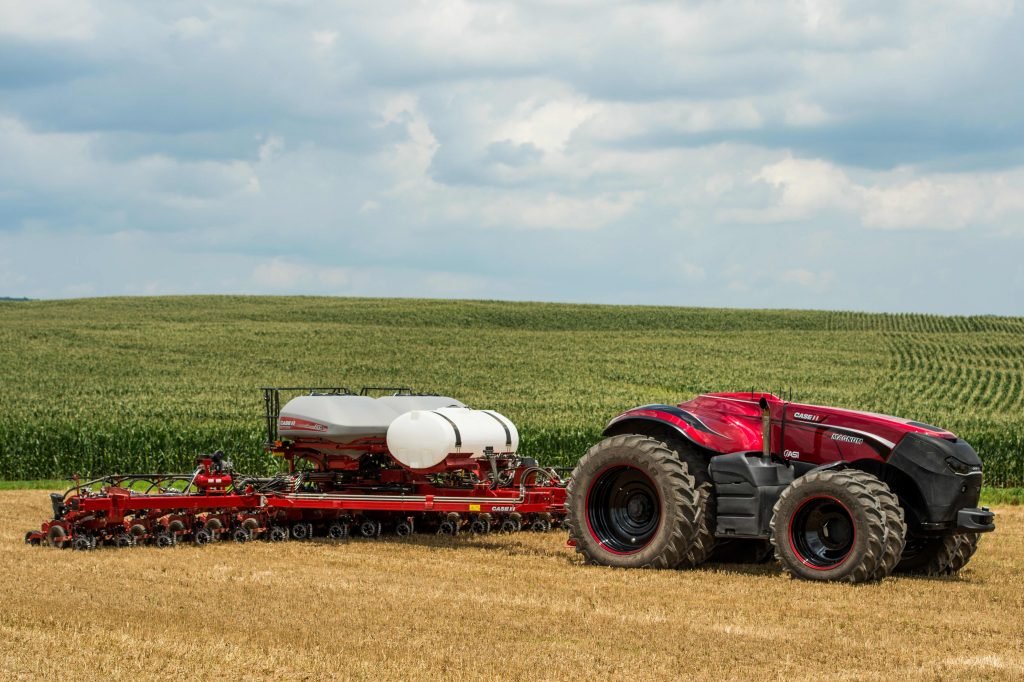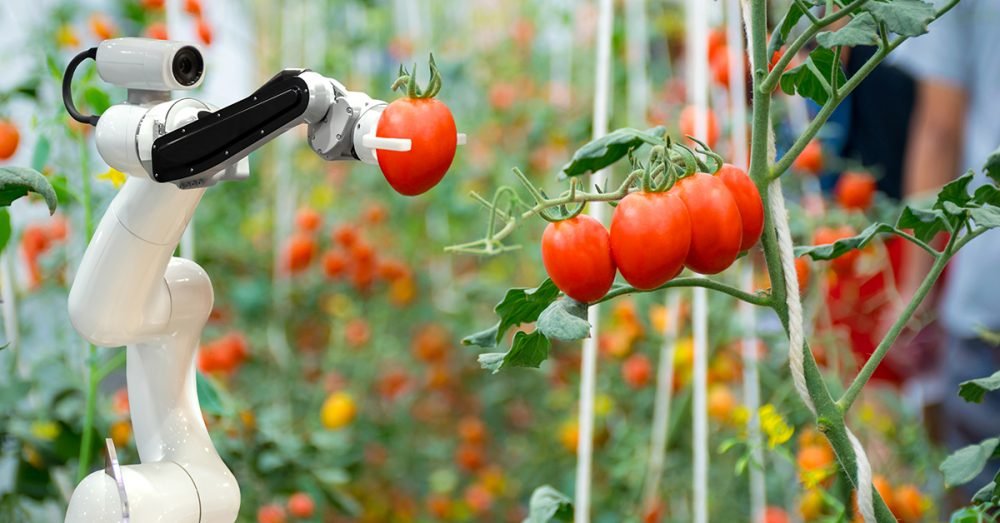How robots are used in agriculture? Agriculture has always been a labour-intensive industry. Farmers work tirelessly to sow, irrigate, and harvest their crops.
In this blog, we will explore the different types of robots used in agriculture, their benefits, limitations, and how they change how we grow and harvest our food.

Table of Contents
How Robots Are Used in Agriculture
However, the advent of robotics has revolutionized the industry. Farmers can now rely on robots to perform many of the tasks traditionally done by humans. Robots are making a difference in agriculture by increasing efficiency, reducing labour costs, and improving crop yields.
Types of Robots Used in Agriculture
Robots are becoming increasingly common in modern agriculture, helping farmers streamline their operations and achieve higher yields. Here are some of the most popular types of robots used in agriculture:
1. Drones

Agricultural drones are unmanned aerial vehicles equipped with sensors and cameras to collect data on crops and soil. They can monitor crop health, detect pests and diseases, and map fields for precision farming. Drones are particularly useful for large-scale operations, as they can cover vast areas quickly and provide real-time data to farmers.
2. Autonomous tractors

These self-driving vehicles can perform various tasks, such as ploughing, planting, and harvesting crops. They are equipped with GPS, sensors, and other technologies, allowing them to navigate fields and perform tasks highly. Autonomous tractors can work continuously, without the need for breaks, and can be operated remotely, which reduces labour costs.
3. Robotic arms

These machines are equipped with various tools to perform tasks such as pruning, harvesting, and packing. They can work tirelessly and precisely, reducing the risk of crop damage. Robotic arms can be programmed to perform specific tasks, making them versatile and efficient.
Recent technological advancements in agricultural robotics include artificial intelligence and machine learning to improve decision-making and automation. For example, some robots can now detect and classify weeds, reducing the need for herbicides and improving crop yields. Robotics companies are also developing robots that can work in adverse weather conditions and harsh environments, such as orchards and vineyards.
Benefits of Using Robots in Agriculture
The use of robots in agriculture provides several benefits to farmers, including:
1. Increased efficiency
Agricultural robots can perform tasks faster and more accurately than humans, increasing productivity and efficiency. For example, autonomous tractors can work 24/7, without breaking or supervision, and can cover more ground in less time.
By automating tasks that would otherwise require human labour, farmers can save on labour costs. This is particularly useful for tasks that are difficult or dangerous for humans, such as harvesting crops in steep terrain or extreme weather conditions.
2. Improved crop yields
Robots can help farmers identify crop problems early on, allowing them to take corrective action before the damage becomes irreversible. For example, drones can detect crop health and yield changes, allowing farmers to adjust fertilizer and water usage to optimize crop growth.
Real-life examples of how farmers have benefitted from using robots in their fields include:
1. Rowbot Systems
This company has developed a robot that can apply fertilizer and herbicides directly to the base of each plant, reducing waste and improving crop yields.
2. Blue River Technology
This company has developed a robotic weed control system that uses computer vision and machine learning to identify and remove weeds without harming crops, reducing the need for herbicides.
3. Harvest CROO Robotics
This company has developed a robotic strawberry picker to identify and pick ripe berries without damaging the plants or fruit. This technology reduces labour costs and increases the efficiency of the harvest.
Overall, the use of robots in agriculture is becoming increasingly popular due to the significant benefits they provide farmers. As technology evolves, we will likely see more innovative and efficient ways to use robots in agriculture.
Read: 5 Terrifying Reasons Why Robots are a Bad Idea – Protect Yourself Now
Challenges and Limitations of Agricultural Robotics
While using robots in agriculture provides significant benefits, there are also some challenges and limitations to consider.
One of the main challenges is the high cost of robotics technology. Many farmers, particularly small-scale farmers, may not have the financial resources to invest in the latest agricultural robotics technology. This limits their access to the latest innovations in the industry, which could reduce their competitiveness in the market.
Another challenge is the need for specialized skills and knowledge to operate and maintain agricultural robots. Farmers may need to invest in training their workforce to operate and maintain these robots, which can add to the overall costs.
Additionally, while robots can automate many routine tasks, they cannot replace human intuition and decision-making. Farmers must still make critical decisions about crop management, soil health, and other crop yield factors. Agricultural robots can provide data and insights, but ultimately, it is up to the farmer to interpret and act on this information.
There are also limitations to the capabilities of agricultural robots. For example, robotic arms may not be able to handle delicate crops or perform tasks that require a high degree of dexterity, such as pruning. Similarly, drones may be unable to collect accurate data in adverse weather conditions, such as heavy rain or strong winds.
Despite these challenges and limitations, the use of agricultural robots continues to gain popularity as technology improves and costs decrease. As the industry evolves, addressing these challenges and limitations will be essential to ensure that farmers can benefit from the latest innovations.
Future of Agricultural Robotics
The future of agricultural robotics is promising, with continued technological advancements driving innovation in the field. The latest trends in agricultural robotics include precision farming and the integration of artificial intelligence (AI) to improve decision-making and increase efficiency.
Precision farming uses data and technology to optimize crop yields and reduce waste. Agricultural robots equipped with sensors and GPS technology can collect data on soil health, moisture levels, and other factors, allowing farmers to make informed decisions about crop management. This technology can also automate tasks such as planting, fertilizing, and harvesting, increasing efficiency and reducing costs.
Artificial intelligence is also integrated into agricultural robotics, allowing robots to learn and adapt to changing conditions. AI algorithms can analyze data collected by agricultural robots, provide insights into crop health and growth, and predict potential issues before they occur.
Agricultural robots will continue to transform how we grow, harvest, and distribute food. With the world’s population expected to reach 9 billion by 2050, there is an increasing demand for food production. Agricultural robots can help meet this demand by increasing efficiency, reducing waste, and improving crop yields.
In the future, we can expect to see more specialized agricultural robots that can handle specific tasks, such as planting or harvesting specific crops. We may also see the development of collaborative robots, which can work alongside human labourers to increase productivity and efficiency.
Overall, the future of agricultural robotics is exciting, and we can expect to see continued advancements that will shape the future of farming.
Conclusion
In conclusion, using robots in agriculture provides significant benefits, including increased efficiency, reduced labour costs, and improved crop yields. While there are challenges and limitations to consider, the continued advancements in agricultural robotics make it a promising technology for the future of farming.
Robots will play a crucial role in the future of agriculture, as they can help meet the increasing demand for food production and address challenges such as climate change and labour shortages. By embracing the latest agricultural technologies, farmers can improve their yields and profits while reducing their environmental impact.
Therefore, it is essential for farmers to stay up-to-date with the latest trends and advancements in agricultural robotics and to consider investing in this technology where appropriate. As the industry continues to evolve, we expect to see more innovations that will transform how we grow, harvest, and distribute food.








